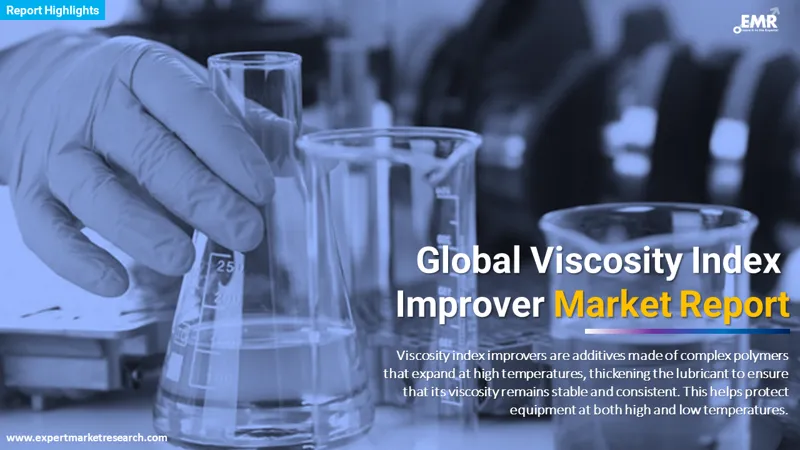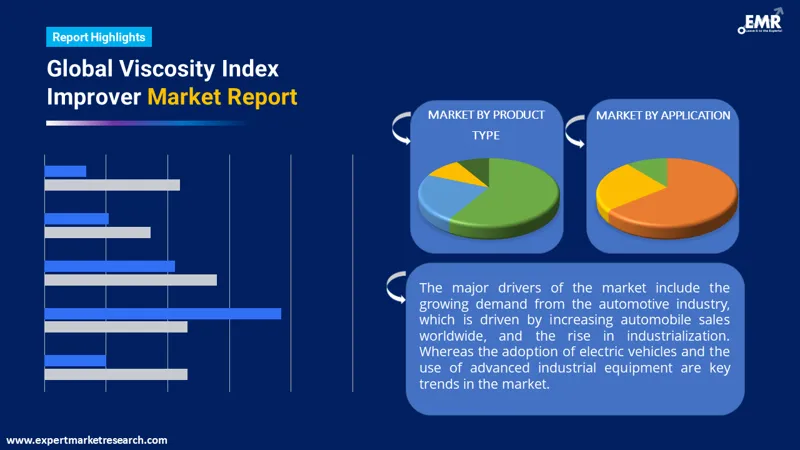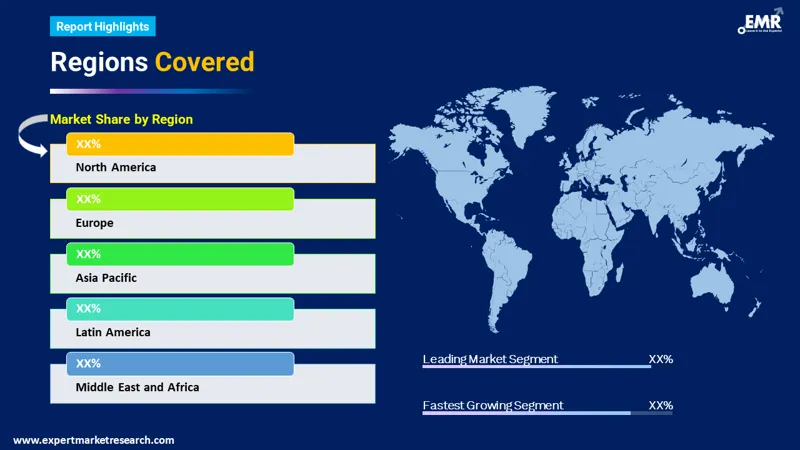Reports
Sale

Global Viscosity Index Improver Market: By Product Type: Polymethylacrylate (PMA), Ethylene Propylene Copolymer (OCP), Hydrostyrene Diene Copolymer (HSD), Polyisobutylene (PIB), Others; By Application: Automotive Lubricants, Industrial Lubricants; Regional Analysis; Competitive Landscape; Industry Events and Developments; 2024-2032
Global Viscosity Index Improver Market Outlook
The global viscosity index improver market is expected to grow at a CAGR of 4.3% during the period 2024-2032. Viscosity index improvers are widely employed in gear oils, multigrade engine oils, automatic transmission fluids, power-steering fluids, greases and some types of hydraulic fluid.

Read more about this report - REQUEST FREE SAMPLE COPY IN PDF
The most regular application is for heavy-duty trucks and passenger cars. Materials usually employed to prepare viscosity index improvers include radial polyisoprene, polyisobutylene (PIB), polymethacrylates (PMA) and olefin co-polymers (OCP). Europe, North America, and Asia are likely to be significant markets.
Global Market Likely to be Boosted by Uses in Industrial and Automotive Lubricant Formulations
Viscosity control versus temperature change is a key aspect of an effective and enduring lubricant. Several applications rotate between hot and cold operating temperatures and warrant similar levels of protection and lubrication all through the process.
Viscosity index improvers or viscosity modifiers prevent lubricant thinning at higher temperatures. Decreased lubricant viscosity and resultant thinning of the lubricant may diminish the protective properties of the lubricant and cause damage to the equipment.
Viscosity index improvers are complex polymer additives that expand at higher temperatures to thicken the lubricant to make sure that the viscosity remains consistent and stable, protecting the equipment at high as well as low temperatures. Viscosity improvers enable multigrade oil formulation which eliminates the need for cyclical oil changes. The choice of viscosity index improver depends on considerations of finished fluid requirements. Polymers with high molecular weight display superior thickening efficiency, but are more prone to mechanical shear; on the other hand, polymers with lower molecular weight exhibit better shear stability but need to be employed at a higher treat rate. Some types of polymer are susceptible to oxidative and thermal degradation at elevated temperatures, thus, it becomes necessary to choose a polymer with higher oxidative and thermal stability.
Solutions by Leading Companies Expected to Stimulate Market Growth
Companies like Afton offer many types of polymer-based viscosity index improvers that function effectively in a broad range of mineral oil lubricant applications. Afton offers a variety of Olefin Copolymer (OCP) viscosity index improvers in liquid as well as solid forms. These OCP VIIs are oil soluble and well-suited to several different lubricant formulations. The company also offers many Polymethacrylate (PMA) based viscosity index improvers (VII) that may be used in multiple industrial and automotive lubricant formulations. Afton's HiTEC® Viscosity Index Improvers may also be employed in many non-lubricant related uses.
Evonik's Oil Additives Team provides a wide range of viscosity index improvers for economical blending of high performance driveline fluids with superior thickening efficiency. VISCOPLEX® solutions allow optimum energy efficiency, decreased torque loss, lesser operating temperatures and service life component durability. Functionalized variants allow achievement of prolonged fluid service life.
RiiSO distributes a variety of viscosity index improvers for the production of high quality lubricants. TRiiSO distributes solid viscosity index improvers in bale form as well as in pellets; it also distributes liquid viscosity index improver additives.
Such solutions by solution-providers are likely to drive the global viscosity index improver market.
Demand for More Fuel-efficient Lubricants that Display Higher Performance Expected to Boost Market Growth
Sectors such as OEMs, manufacturers of passenger vehicles, heavy duty equipment, and lubricant end-users continually demand more fuel-efficient enduring and better performing lubricants. Such demand for fluids that display superior function in severe conditions and are usable all the year round in all types of climate has led to increased use of high viscosity index high performance fluids in automotive and industrial applications. To fulfil such demands, companies like Lubrizol offer efficient solutions. Lubrizol has devised an advanced polymer additive technology called Asteric™; the technology enables polymer architecture control otherwise not possible with conventional polymer additives. Such offerings are expected to boost the global viscosity index improver market.
Market Segmentation

Read more about this report - REQUEST FREE SAMPLE COPY IN PDF
By product type, the market is segmented into:
- Polymethylacrylate (PMA)
- Ethylene Propylene Copolymer (OCP)
- Hydrostyrene Diene Copolymer (HSD)
- Polyisobutylene (PIB)
- Others
By application, the market is divided into:
- Automotive Lubricants
- Industrial Lubricants
By region, the market is classified into:
- Europe
- North America
- Latin America
- Asia Pacific
- Middle East and Africa

Read more about this report - REQUEST FREE SAMPLE COPY IN PDF
Key Industry Players in the Market
The report extensively analyses significant players in the global viscosity index improver market, assesses their capacity, and observes newest developments like capacity expansions, plant turnarounds, and mergers and acquisitions:
- Infineum International Limited
- Chevron Oronite
- The Lubrizol Corporation
- Sanyo Chemical Industries
- LANXESS AG
- Others
Key Highlights of the Report
| REPORT FEATURES | DETAILS |
| Base Year | 2023 |
| Historical Period | 2018-2023 |
| Forecast Period | 2024-2032 |
| Scope of the Report |
Historical and Forecast Trends, Industry Drivers and Constraints, Historical and Forecast Market Analysis by Segment:
|
| Breakup by Product Type |
|
| Breakup by Application |
|
| Breakup by Region |
|
| Market Dynamics |
|
| Competitive Landscape |
|
| Companies Covered |
|
*At Expert Market Research, we strive to always give you current and accurate information. The numbers depicted in the description are indicative and may differ from the actual numbers in the final EMR report.
1 Preface
2 Report Coverage – Key Segmentation and Scope
3 Report Description
3.1 Market Definition and Outlook
3.2 Properties and Applications
3.3 Market Analysis
3.4 Key Players
4 Key Assumptions
5 Executive Summary
5.1 Overview
5.2 Key Drivers
5.3 Key Developments
5.4 Competitive Structure
5.5 Key Industrial Trends
6 Market Snapshot
6.1 Global
6.2 Regional
7 Industry Opportunities and Challenges
8 Global Viscosity Index Improver Market Analysis
8.1 Key Industry Highlights
8.2 Global Viscosity Index Improver Historical Market (2018-2023)
8.3 Global Viscosity Index Improver Market Forecast (2024-2032)
8.4 Global Viscosity Index Improver Market by Product Type
8.4.1 Polymethylacrylate (PMA)
8.4.1.1 Market Share
8.4.1.2 Historical Trend (2018-2023)
8.4.1.3 Forecast Trend (2024-2032)
8.4.2 Ethylene Propylene Copolymer (OCP)
8.4.2.1 Market Share
8.4.2.2 Historical Trend (2018-2023)
8.4.2.3 Forecast Trend (2024-2032)
8.4.3 Hydrostyrene Diene Copolymer (HSD)
8.4.3.1 Market Share
8.4.3.2 Historical Trend (2018-2023)
8.4.3.3 Forecast Trend (2024-2032)
8.4.4 Polyisobutylene (PIB)
8.4.4.1 Market Share
8.4.4.2 Historical Trend (2018-2023)
8.4.4.3 Forecast Trend (2024-2032)
8.4.5 Others
8.5 Global Viscosity Index Improver Market by Application
8.5.1 Automotive Lubricants
8.5.1.1 Market Share
8.5.1.2 Historical Trend (2018-2023)
8.5.1.3 Forecast Trend (2024-2032)
8.5.2 Industrial Lubricants
8.5.2.1 Market Share
8.5.2.2 Historical Trend (2018-2023)
8.5.2.3 Forecast Trend (2024-2032)
8.6 Global Viscosity Index Improver Market by Region
8.6.1 Market Share
8.6.1.1 North America
8.6.1.2 Europe
8.6.1.3 Asia Pacific
8.6.1.4 Latin America
8.6.1.5 Middle East and Africa
9 Regional Analysis
9.1 North America
9.1.1 Historical Trend (2018-2023)
9.1.2 Forecast Trend (2024-2032)
9.1.3 Breakup by Country
9.1.3.1 United States of America
9.1.3.2 Canada
9.2 Europe
9.2.1 Historical Trend (2018-2023)
9.2.2 Forecast Trend (2024-2032)
9.2.3 Breakup by Country
9.2.3.1 United Kingdom
9.2.3.2 Germany
9.2.3.3 France
9.2.3.4 Italy
9.2.3.5 Others
9.3 Asia Pacific
9.3.1 Historical Trend (2018-2023)
9.3.2 Forecast Trend (2024-2032)
9.3.3 Breakup by Country
9.3.3.1 China
9.3.3.2 Japan
9.3.3.3 India
9.3.3.4 ASEAN
9.3.3.5 Australia
9.3.3.6 Others
9.4 Latin America
9.4.1 Historical Trend (2018-2023)
9.4.2 Forecast Trend (2024-2032)
9.4.3 Breakup by Country
9.4.3.1 Brazil
9.4.3.2 Argentina
9.4.3.3 Mexico
9.4.3.4 Others
9.5 Middle East and Africa
9.5.1 Historical Trend (2018-2023)
9.5.2 Forecast Trend (2024-2032)
9.5.3 Breakup by Country
9.5.3.1 Saudi Arabia
9.5.3.2 United Arab Emirates
9.5.3.3 Nigeria
9.5.3.4 South Africa
9.5.3.5 Others
10 Market Dynamics
10.1 SWOT Analysis
10.1.1 Strengths
10.1.2 Weaknesses
10.1.3 Opportunities
10.1.4 Threats
10.2 Porter’s Five Forces Analysis
10.2.1 Supplier’s Power
10.2.2 Buyer’s Power
10.2.3 Threat of New Entrants
10.2.4 Degree of Rivalry
10.2.5 Threat of Substitutes
10.3 Key Indicators for Demand
10.4 Key Indicators for Price
11 Value Chain Analysis
12 Competitive Landscape
12.1 Market Structure
12.2 Company Profiles
12.2.1 Infineum International Limited
12.2.1.1 Company Overview
12.2.1.2 Product Portfolio
12.2.1.3 Demographic Reach and Achievements
12.2.1.4 Certifications
12.2.2 Chevron Oronite
12.2.2.1 Company Overview
12.2.2.2 Product Portfolio
12.2.2.3 Demographic Reach and Achievements
12.2.2.4 Certifications
12.2.3 The Lubrizol Corporation
12.2.3.1 Company Overview
12.2.3.2 Product Portfolio
12.2.3.3 Demographic Reach and Achievements
12.2.3.4 Certifications
12.2.4 Sanyo Chemical Industries
12.2.4.1 Company Overview
12.2.4.2 Product Portfolio
12.2.4.3 Demographic Reach and Achievements
12.2.4.4 Certifications
12.2.5 LANXESS AG
12.2.5.1 Company Overview
12.2.5.2 Product Portfolio
12.2.5.3 Demographic Reach and Achievements
12.2.5.4 Certifications
12.2.6 Others
13 Industry Events and Developments
List of Key Figures and Tables
1. Global Viscosity Index Improver Market: Key Industry Highlights, 2018 and 2032
2. Global Viscosity Index Improver Historical Market: Breakup by Product Type (USD Million), 2018-2023
3. Global Viscosity Index Improver Market Forecast: Breakup by Product Type (USD Million), 2024-2032
4. Global Viscosity Index Improver Historical Market: Breakup by Application (USD Million), 2018-2023
5. Global Viscosity Index Improver Market Forecast: Breakup by Application (USD Million), 2024-2032
6. Global Viscosity Index Improver Historical Market: Breakup by Region (USD Million), 2018-2023
7. Global Viscosity Index Improver Market Forecast: Breakup by Region (USD Million), 2024-2032
8. North America Viscosity Index Improver Historical Market: Breakup by Country (USD Million), 2018-2023
9. North America Viscosity Index Improver Market Forecast: Breakup by Country (USD Million), 2024-2032
10. Europe Viscosity Index Improver Historical Market: Breakup by Country (USD Million), 2018-2023
11. Europe Viscosity Index Improver Market Forecast: Breakup by Country (USD Million), 2024-2032
12. Asia Pacific Viscosity Index Improver Historical Market: Breakup by Country (USD Million), 2018-2023
13. Asia Pacific Viscosity Index Improver Market Forecast: Breakup by Country (USD Million), 2024-2032
14. Latin America Viscosity Index Improver Historical Market: Breakup by Country (USD Million), 2018-2023
15. Latin America Viscosity Index Improver Market Forecast: Breakup by Country (USD Million), 2024-2032
16. Middle East and Africa Viscosity Index Improver Historical Market: Breakup by Country (USD Million), 2018-2023
17. Middle East and Africa Viscosity Index Improver Market Forecast: Breakup by Country (USD Million), 2024-2032
18. Global Viscosity Index Improver Market Structure
The market is assessed to grow at a CAGR of 4.3% between 2024 and 2032.
The major market drivers are the growing automotive industry coupled with an upsurge in global automobile sales and rising industrialisation.
The key market trends include the increasing adoption of electric vehicles and use of sophisticated industrial equipment.
The major regions in the market are North America, Europe, the Asia Pacific, Latin America, and the Middle East and Africa.
The various product types in the market for viscosity index improvers include polymethylacrylate (PMA), ethylene propylene copolymer (OCP), hydrostyrene diene copolymer (HSD), and polyisobutylene (PIB), among others.
The different applications in the market for viscosity index improvers include automotive lubricants and industrial lubricants.
The major players in the market are Infineum International Limited, Chevron Oronite, The Lubrizol Corporation, Sanyo Chemical Industries, and LANXESS AG, among others.
The significance of viscosity is that it defines the internal friction of a moving fluid.
A higher viscosity index indicates a slower flowing fluid as well as a thicker fluid.
Mini Report
-
Selected Sections, One User
-
Printing Not Allowed
-
Email Delivery in PDF
-
Free Limited Customisation -
Post Sales Analyst Support -
50% Discount on Next Update
Single User License
-
All Sections, One User
-
One Print Allowed
-
Email Delivery in PDF
-
Free Limited Customisation -
Post Sales Analyst Support -
50% Discount on Next Update

Five User License
-
All Sections, Five Users
-
Five Prints Allowed
-
Email Delivery in PDF
-
Free Limited Customisation
-
Post Sales Analyst Support
-
50% Discount on Next Update
Corporate License
-
All Sections, Unlimited Users
-
Unlimited Prints Allowed
-
Email Delivery in PDF + Excel
-
Free Limited Customisation
-
Post Sales Analyst Support
-
50% Discount on Next Update
Any Question? Speak With An Analyst
View A Sample
Did You Miss Anything, Ask Now
Right People
We are technically excellent, strategic, practical, experienced and efficient; our analysts are hand-picked based on having the right attributes to work successfully and execute projects based on your expectations.
Right Methodology
We leverage our cutting-edge technology, our access to trusted databases, and our knowledge of the current models used in the market to deliver you research solutions that are tailored to your needs and put you ahead of the curve.
Right Price
We deliver in-depth and superior quality research in prices that are reasonable, unmatchable, and shows our understanding of your resource structure. We, additionally, offer attractive discounts on our upcoming reports.
Right Support
Our team of expert analysts are at your beck and call to deliver you optimum results that are customised to meet your precise needs within the specified timeframe and help you form a better understanding of the industry.


